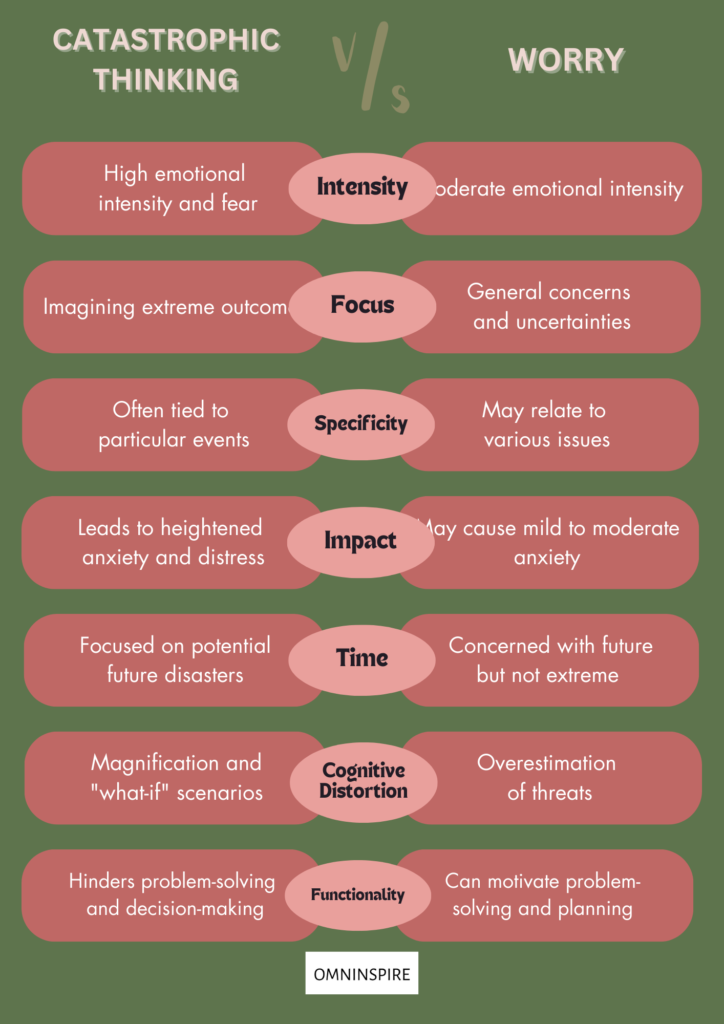Image Source : Freepik
Edited By : OMNINSPIRE
In the realm of human cognition, our minds are constantly at work, processing thoughts, concerns, and possibilities. Two common cognitive patterns that frequently emerge in our mental landscape are catastrophic thinking and worry. While they both involve contemplating potential negative outcomes, they are distinct in their nature, scope, and impact. In this article, we will delve into the nuances of these cognitive processes, exploring what sets them apart and how recognizing these differences can be pivotal for our mental well-being.
Catastrophic Thinking: The Storm of Extreme Imagination
Scope and Extremity:
Catastrophic thinking is characterized by its tendency to envision the absolute worst-case scenario in any given situation. It thrives on extremity, conjuring up the most dire and improbable outcomes. When one engages in catastrophic thinking, they often leap to the most severe and exaggerated conclusions. For instance, being a few minutes late for an appointment might lead to the fear of losing one’s job and facing financial ruin.
Emotional Intensity:
The hallmark of catastrophic thinking is its ability to trigger intense emotional reactions. Anxiety, fear, and distress are its frequent companions. These emotions can be overwhelming, often propelling individuals into a state of panic or despair. Catastrophic thinkers experience the emotional storm at its height, with each thought intensifying their sense of impending doom.
Rationality:
Catastrophic thinking tends to lack a rational basis. It is driven primarily by fear and anxiety, rather than grounded in empirical evidence or logical reasoning. The thoughts generated by catastrophic thinking are often irrational and unrealistic, fueled by an emotional response to perceived threats.
Focus:
This cognitive pattern fixates on a single negative event or a very narrow set of circumstances. Catastrophic thinkers hone in on the potential catastrophe, magnifying it to an extreme degree. This narrow focus makes it difficult to consider alternative perspectives or recognize any positive aspects of the situation.
Worry: The Broader Spectrum of Concern
Scope:
Worry, on the other hand, is a more generalized form of thinking about potential problems or concerns. It encompasses a wide range of issues, from everyday hassles to significant life events. Unlike catastrophic thinking, worry doesn’t always involve extreme scenarios.
Emotional Intensity:
While worry can evoke emotional responses, these emotions are typically less intense compared to catastrophic thinking. Worry may cause anxiety and mild distress, but it is often more manageable in terms of emotional impact. It doesn’t push individuals to the brink of panic.
Rationality:
Worry tends to have a rational basis. It often stems from genuine concerns or problems that individuals need to address. For instance, worrying about a looming work deadline is a rational response to a real obligation.
Focus:
Worry can be more diffuse, covering a broader spectrum of concerns. It may involve thinking about multiple potential problems or outcomes simultaneously. Unlike catastrophic thinking, worry doesn’t fixate on a single catastrophic event.
Differences Between Catastrophic Thinking and Worry
Understanding the distinctions between catastrophic thinking and worry can be pivotal for our mental health and well-being. Recognizing when we are engaging in catastrophic thinking can help us take a step back, challenge irrational thoughts, and manage the intense emotions that accompany them. Conversely, acknowledging when we are simply worrying about realistic concerns allows us to address those issues more effectively.
We also hear things like “He worries a lot more than he works” or some people may even justify their catastrophic thinking as “they are analysing the situation in multiple ways so that they don’t fail or get hurt and so worrying is a burden on every intelligent man’s shoulders!!”
These are all just mis-interpretation of worrying. As a matter of fact worrying is a positive state of mind when compared to catastrophic thinking (until it doesn’t cripple you from doing what you need to do to overcome the situation).
Understanding the difference between catastrophic thinking and worry will improve your emotional intelligence and build resilience.

In conclusion, both catastrophic thinking and worry are part of the human experience, but they differ significantly in scope, emotional intensity, rationality, and focus. By becoming more aware of these cognitive patterns and their differences, we can develop strategies to manage them effectively, allowing us to navigate life’s challenges with greater clarity and resilience.


